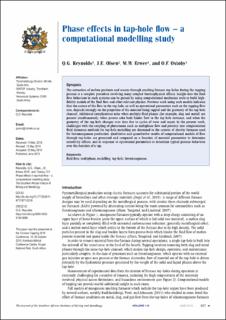| dc.contributor.author | Reynolds, Quinn | |
| dc.contributor.author | Olsen, Jan Erik | |
| dc.contributor.author | Erwee, Markus | |
| dc.contributor.author | Oxtoby, Oliver | |
| dc.date.accessioned | 2020-11-12T11:58:36Z | |
| dc.date.available | 2020-11-12T11:58:36Z | |
| dc.date.created | 2020-01-08T10:44:44Z | |
| dc.date.issued | 2019 | |
| dc.identifier.citation | The Southern African Journal of Mining and Metallurgy. 2019, 119 (6), 527-536. | en_US |
| dc.identifier.issn | 2225-6253 | |
| dc.identifier.uri | https://hdl.handle.net/11250/2687580 | |
| dc.description.abstract | The extraction of molten products and wastes through smelting furnace tap-holes during the tapping process is a complex procedure involving many coupled thermophysical effects. Insight into the fluid flow behaviour in such systems can be gained by using computational mechanics tools to build high-fidelity models of the fluid flow and other relevant physics. Previous work using such models indicates that the nature of the flow in the tap-hole, as well as operational parameters such as the tapping flow rate, depends strongly on the properties of the material being tapped and the geometry of the tap-hole channel. Additional complications arise when multiple fluid phases (for example, slag and metal) are present simultaneously, when porous coke beds hinder flow to the tap-hole entrance, and when the geometry of the tap-hole changes over time due to cycles of wear and repair. In the present work, challenges with the coupling of phenomena such as multiphase flow and porosity into computational fluid dynamics methods for tap-hole modelling are discussed in the context of electric furnaces used for ferromanganese production. Qualitative and quantitative results of computational models of flow through tap-holes are presented and compared as a function of material parameters to determine sensitivity effects, and in response to operational parameters to determine typical process behaviour over the duration of a tap. | en_US |
| dc.language.iso | eng | en_US |
| dc.publisher | SAIMM | en_US |
| dc.relation.uri | http://www.scielo.org.za/pdf/jsaimm/v119n6/04.pdf | |
| dc.rights | Navngivelse 4.0 Internasjonal | * |
| dc.rights.uri | http://creativecommons.org/licenses/by/4.0/deed.no | * |
| dc.subject | ferromanganese | en_US |
| dc.subject | tap-hole | en_US |
| dc.subject | modelling | en_US |
| dc.subject | multiphase | en_US |
| dc.subject | fluid flow | en_US |
| dc.title | Phase effects in tap-hole flow-a computational modelling study | en_US |
| dc.type | Peer reviewed | en_US |
| dc.type | Journal article | en_US |
| dc.description.version | publishedVersion | en_US |
| dc.rights.holder | @ The Authors | en_US |
| dc.source.pagenumber | 527-536 | en_US |
| dc.source.volume | 119 | en_US |
| dc.source.journal | The Southern African Journal of Mining and Metallurgy | en_US |
| dc.source.issue | 6 | en_US |
| dc.identifier.doi | 10.17159/2411-9717/671/2019 | |
| dc.identifier.cristin | 1768336 | |
| cristin.unitcode | 7401,80,40,0 | |
| cristin.unitname | Prosessteknologi | |
| cristin.ispublished | true | |
| cristin.fulltext | original | |
| cristin.qualitycode | 1 | |

